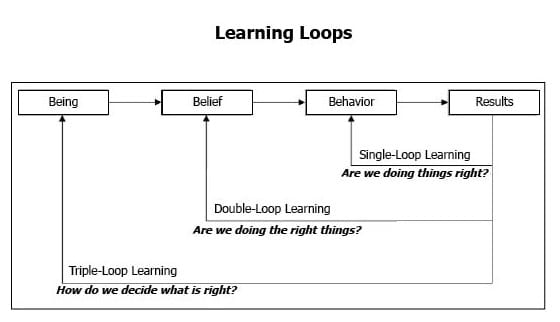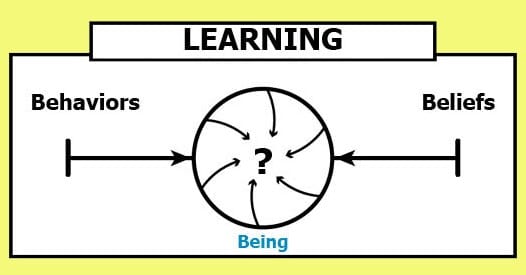Today we can no longer just tweak old skill sets and behaviours to optimize our performance because the challenges presented to us are of a new character. Furthermore, reframing our assumptions and beliefs systems, although additive, is not going to solve the complex global issues confronting us. We recognize the need to place ourselves on a new learning curve of exploration, discovery and innovation.
This innovation curve as coined by Richard Foster (1986) requires us to entertain our uncertainty and confusion with curiosity and wonderment. This is a very different approach to learning than detecting and correcting errors, which Chris Argyrus (1970), defines as single and double-loop learning.
In single-loop learning, our main focus is external and all about changing our behaviour to improve our performance. We might learn new skills, procedures, rules and take incremental steps toward doing “something” better. For instance, when I began to roller blade, I took lessons that provided me with techniques and practice to greatly improve my ability.
In double-loop learning, the focus shifts from external to internal where we begin the process of improving our thinking in order to do “something” different. We change our beliefs, mental models or operating assumptions in order to change the source or cause of the behaviour rather than only the behaviour.
In an organizational context, we might analyze work processes to understand patterns of interaction and gather insights about new forms of decision-making. In a personal example, I shifted my belief from “I’ll believe it when I see it” to “I’ll see it when I believe it” in order to fully access and experience my intuitive intelligence—which isn’t so much about doing things right but rather about doing the right things. We do the right things by questioning goals, beliefs, rules, procedures and mental models and then changing them appropriately. We change our inner experience in order to change our outer experience.
A third type of learning, which is much less understood or written about, is triple-loop learning where we construct new ways of:
• seeing,
• interpreting what we see, and
• being with what we see,
or as Gandhi stated, we “become” the change we wish to see. Our insights are internalized and integrated into a new identity. We find ourselves transformed from the proverbial caterpillar to a butterfly, and we understand how we accomplished this. We learned how to learn.
Let me run you through an example using all three loops with smoking cessation. As a single-loop learner, I quit smoking “cold turkey” without ever understanding the source or cause of my choosing to smoke. As a double-loop learner, I discovered the reason I smoked was because I held a belief I was not a worthy person (not good enough) and used smoking to nurture myself. When I came to understand this irrational fear, belief and behaviour, I reframed my belief to one of worthiness. As a triple-loop learner, I practiced “right mindfulness” with regard to my new sense of worth (my new principle) and aligned my thoughts, words and deeds to match. I became, instead of an ex-smoker, someone who responded in the world as though I was always a non-smoker. In essence, I changed my identity – smoker, ex-smoker, non-smoker – and I learned how to learn so I would not just replace one addiction with another. Without question, it requires deep reflection and deep diligence on our part to transform not just our behaviour and beliefs but our actual being.
 Source adapted from: http://managementhelp.org/misc/learning-types-loops.pdf
Source adapted from: http://managementhelp.org/misc/learning-types-loops.pdf
To put learning in an organizational perspective, most organizations operate through single-loop learning—Are we doing things right? However, during times of complexity, uncertainty and rapid change, double-loop learning (creativity, critical thinking and changing the rules) is essential—Are we doing the right things? As for triple-loop learning in organizations, it is epitomized in the phrase “walking the talk”—How do we decide what is right and then be it? Are our organizations and businesses engaged in “being” authentic and principled in their brands, communications, policies and procedures, products and services?
I might suggest that the learning paradox we have witnessed for some time in the business world is the pull of organizations to stay entrenched in their single-loop learning mode (changing behaviour by creating greater efficiencies) and the opposing push of their workforce to be creative and change their beliefs (double-loop learning). What are your thoughts regarding past learning paradigms? And would you say that the convergence of these two opposing forces might be transformation (triple-loop learning) or being the change we wish to see?
References:
Argyrus, Chris. (1970). Personality and Organization: The Conflict Between System and the Individual.
Argyrus, Chris. (1995). On Organizational Learning. Blackwell Publishers.
Foster, Richard. (1986a). Innovation: The Attacker’s Advantage. Summit Books.
Hargrave, Robert. (1995). Masterful Coaching: Extraordinary Results by Impacting People and the Way They Think and Work Together, Jossey-Bass.
Senge, Peter. (1990). The Fifth Discipline; the Art & Practice of the Learning Organization. DD Currency, NY.





